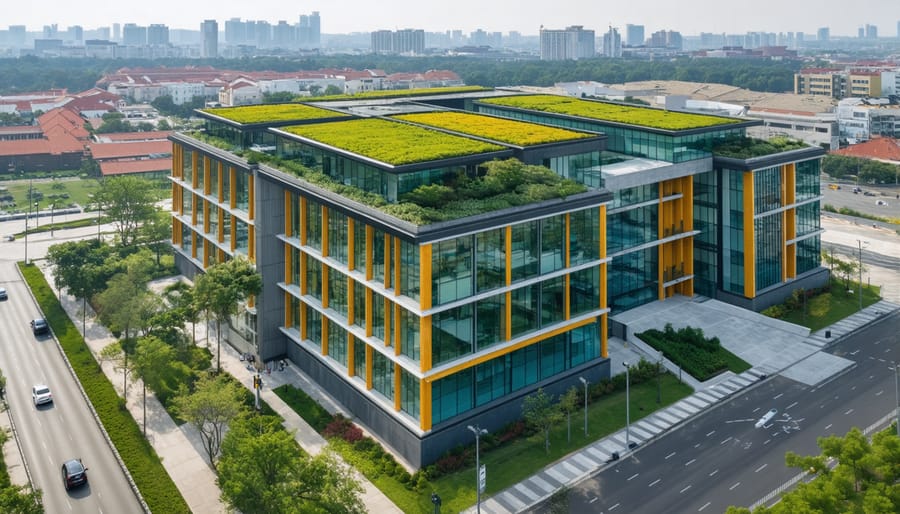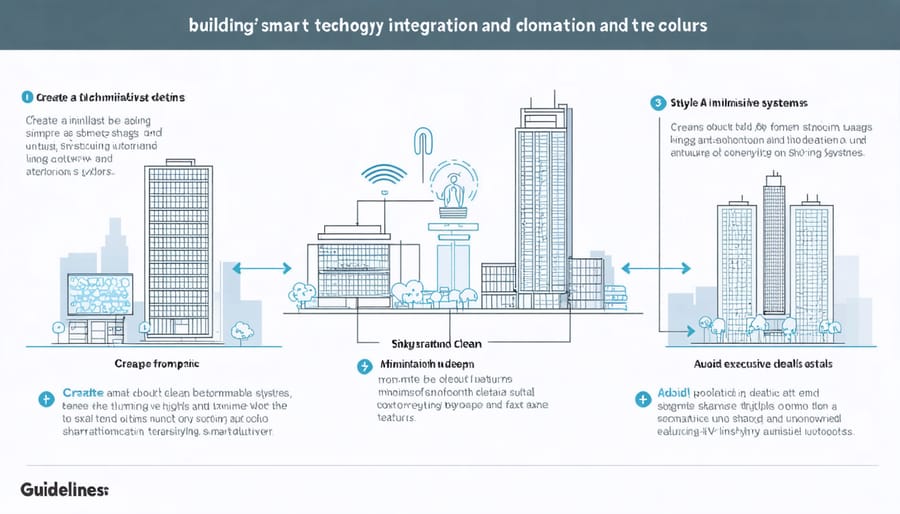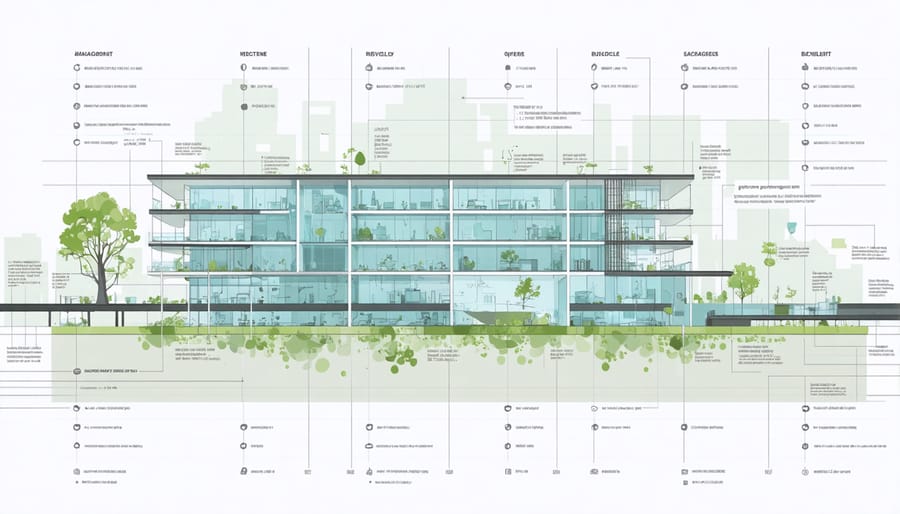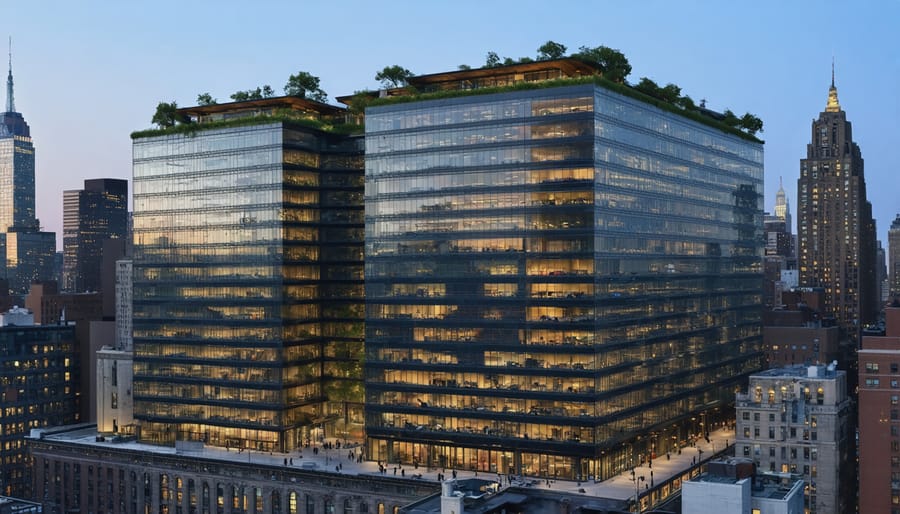S&P Global’s new headquarters in Manhattan stands as a testament to next-generation sustainable architecture, merging cutting-edge design with environmental responsibility. Rising 64 stories above the vibrant Financial District, this LEED Platinum-certified structure represents a pivotal shift in corporate building standards and smart city development.
The 1.4 million-square-foot tower exemplifies how modern commercial architecture can simultaneously address climate challenges, workplace evolution, and urban integration. Its double-skin façade system reduces energy consumption by 40% compared to conventional buildings, while its advanced air filtration and touchless technologies set new benchmarks for post-pandemic office environments.
Beyond its technical achievements, the building serves as a catalyst for sustainable urban development, demonstrating how corporate architecture can drive industry transformation. The structure’s innovative design, incorporating regenerative energy systems and biophilic elements, has already influenced building codes and sustainability standards across major metropolitan areas.
This landmark project not only redefines the parameters of sustainable commercial construction but also establishes a new paradigm for how global organizations can align their physical infrastructure with environmental stewardship and employee wellbeing.

Architectural Innovation and Design Features
Smart Building Technologies
The S&P Global building showcases cutting-edge smart technologies that seamlessly integrate with sustainable design practices to create an intelligent workplace ecosystem. At its core, the building utilizes a centralized Building Management System (BMS) that coordinates multiple automated systems through a unified platform.
The building’s smart lighting system employs daylight harvesting and occupancy sensing, automatically adjusting illumination levels based on natural light availability and space utilization. Advanced HVAC controls incorporate predictive analytics and real-time occupancy data to optimize temperature regulation and air quality while minimizing energy consumption.
IoT sensors throughout the facility collect and analyze data on space utilization, environmental conditions, and energy usage patterns. This information feeds into a sophisticated analytics platform that continuously optimizes building performance and occupant comfort. The smart elevator system uses destination dispatch algorithms to reduce wait times and energy usage during peak hours.
Security features include biometric access control, AI-powered surveillance, and automated visitor management systems. The building’s network infrastructure supports high-speed connectivity and secure data transmission, essential for modern workplace operations. Mobile applications allow occupants to control their immediate environment, book meeting spaces, and receive real-time building updates.
These integrated technologies demonstrate how modern commercial buildings can achieve operational efficiency while enhancing occupant experience through automated, data-driven solutions.

Sustainable Materials and Construction Methods
The S&P Global building exemplifies leadership in sustainable construction through its innovative use of environmentally conscious materials and methods. The structure incorporates several green building innovations, including advanced recycled steel composites that reduce the overall carbon footprint while maintaining structural integrity.
The building’s facade features high-performance glazing systems with integrated photovoltaic elements, maximizing natural light while generating clean energy. Concrete mixtures used throughout the structure contain up to 30% recycled content, including fly ash and slag cement, significantly reducing embodied carbon compared to traditional formulations.
Construction methods prioritized prefabrication and modular assembly techniques, minimizing on-site waste and reducing construction time by approximately 20%. The project implemented a comprehensive waste management system that achieved an impressive 95% diversion rate from landfills.
Notable innovations include the use of bio-based insulation materials derived from agricultural waste products and low-VOC finishing materials that enhance indoor air quality. The building’s structural system incorporates mass timber elements in non-critical areas, demonstrating the viability of renewable materials in commercial construction.
These sustainable choices not only minimize environmental impact but also contribute to operational efficiency and occupant wellbeing, setting new standards for responsible commercial construction.
Environmental Performance Metrics
Energy Efficiency Solutions
The S&P Global building exemplifies cutting-edge energy efficiency through a comprehensive suite of integrated solutions. At its core, the building employs advanced IoT and smart building systems that continuously monitor and optimize energy consumption across all operations.
The building’s envelope features high-performance glazing with dynamic tinting capabilities, reducing solar heat gain while maximizing natural daylight penetration. This is complemented by a state-of-the-art HVAC system utilizing variable refrigerant flow technology, achieving 40% greater efficiency compared to conventional systems.
Renewable energy integration plays a crucial role, with a 50kW rooftop solar array providing approximately 15% of the building’s daily power requirements. The implementation of a ground-source heat pump system further reduces reliance on grid electricity for heating and cooling operations.
Energy recovery ventilation systems capture and reuse thermal energy from exhaust air, while LED lighting with daylight harvesting sensors automatically adjusts illumination levels based on natural light availability. The building’s advanced power management system includes real-time energy monitoring and predictive maintenance capabilities, ensuring optimal performance of all systems.
Water efficiency measures include rainwater harvesting systems and greywater recycling, reducing potable water consumption by 35%. The integration of these solutions has earned the building LEED Platinum certification and positions it as a benchmark for sustainable commercial construction, demonstrating how strategic investment in energy-efficient technologies can deliver both environmental and economic benefits.
Water Management Systems
The S&P Global building incorporates state-of-the-art water management systems designed to minimize environmental impact while maximizing efficiency. The integrated system reduces potable water consumption by approximately 40% compared to conventional office buildings of similar size.
At the heart of the building’s water conservation strategy is a rainwater harvesting system that captures and stores precipitation from the roof surface. This collected water undergoes multi-stage filtration and treatment before being redistributed for non-potable uses, including landscape irrigation and cooling tower makeup water.
The building features dual-plumbing infrastructure, enabling the use of recycled greywater for toilet flushing and other non-potable applications. Low-flow fixtures and sensor-operated faucets throughout the facility contribute to significant water savings, while smart meters monitor consumption patterns in real-time, allowing facility managers to identify and address inefficiencies promptly.
A notable innovation is the condensate recovery system, which collects and repurposes water from the HVAC system’s cooling process. This recovered water supplements the building’s non-potable water supply, further reducing reliance on municipal water sources.
The landscape design incorporates drought-resistant native plants and a high-efficiency drip irrigation system that responds to soil moisture levels and weather conditions. Bioswales and permeable pavements manage stormwater runoff, reducing the burden on local infrastructure while replenishing groundwater.
These integrated water management solutions not only support the building’s LEED Platinum certification but also serve as a model for sustainable water use in commercial construction, demonstrating that significant water conservation is achievable without compromising operational efficiency.

Industry Impact and Future Implications
Market Leadership and Innovation
S&P Global has consistently demonstrated its leadership in driving construction industry innovation through groundbreaking design approaches and technological integration. The building’s development team pioneered several industry-first solutions, including an advanced predictive maintenance system that utilizes machine learning algorithms to optimize building operations and reduce downtime.
The structure’s innovative facade system incorporates smart glass technology that automatically adjusts transparency based on external conditions, significantly reducing energy consumption while maintaining optimal indoor comfort. This adaptive building envelope has since become a benchmark for sustainable commercial construction projects worldwide.
In terms of workplace innovation, the building features flexible floor plates designed to accommodate evolving office requirements, supported by a digital infrastructure that enables seamless connectivity and space utilization tracking. The implementation of IoT sensors throughout the building creates a responsive environment that adapts to occupancy patterns and user preferences.
Notable technological achievements include the development of a proprietary building management platform that integrates multiple systems into a unified control interface. This platform has revolutionized how facility managers monitor and optimize building performance, setting new standards for operational efficiency in commercial buildings.
The project’s success has influenced industry practices, with many subsequent developments adopting similar innovative approaches to sustainable design and smart building technology. S&P Global’s commitment to pushing boundaries has established it as a catalyst for positive change in the construction sector.
Future Construction Trends
The S&P Global building project sets a precedent for future construction trends, particularly in its innovative approach to integrating smart building technologies with sustainable design principles. Industry experts predict that this development will influence construction methodologies across major metropolitan areas, with several key innovations likely to become standard practice.
The project’s modular construction approach, which reduced build time by 30% while maintaining superior quality standards, is expected to reshape traditional construction timelines. Additionally, the building’s advanced IoT infrastructure, incorporating predictive maintenance systems and real-time energy management, demonstrates the potential for intelligent building operations at scale.
Perhaps most significantly, the project’s successful implementation of biophilic design elements combined with cutting-edge materials science has created a blueprint for future urban developments. The integration of vertical gardens with high-performance building envelopes proves that environmental considerations need not compromise architectural ambition.
Construction industry leaders are particularly interested in the project’s digital twin technology, which enables precise monitoring and optimization of building performance. This approach to building management is anticipated to become increasingly prevalent, especially in large-scale commercial developments where operational efficiency is paramount.
These innovations, validated through the S&P Global building’s success, are already influencing design decisions and construction methodologies in projects worldwide, marking a significant shift toward more intelligent, sustainable, and efficient building practices.
The S&P Global building stands as a testament to innovative sustainable design and cutting-edge construction practices, setting new benchmarks for commercial architecture. Its integration of advanced environmental systems, smart building technologies, and sustainable materials demonstrates the viable future of eco-conscious corporate infrastructure. Industry professionals continue to study and implement lessons learned from this project, particularly in areas of energy efficiency and workplace wellness design. Looking ahead, the building’s success is likely to influence future commercial developments, driving increased adoption of similar sustainable practices and technological solutions. As environmental regulations tighten and corporate sustainability goals become more ambitious, the S&P Global building serves as a blueprint for achieving both operational excellence and environmental responsibility. Its impact will undoubtedly shape the next generation of sustainable commercial architecture and construction methodologies.

